Instructions on how to use Windows Sandbox on Windows 10
In the recently updated version, Windows 10 has added a new feature that is Windows Sandbox. It helps you to install and run new software on a standalone operating system. So how to use Windows Sandbox? Let's go with TipsMake.com to find out through the article below!

What is Windows Sandbox?
From Windows 10 build 18305 onwards, Microsoft has incorporated the Windows Sandbox feature into the operating system. It has the function of creating a virtual environment, a new desktop environment, compact and completely independent of the machine's operating system so that you can install and set personal adjustments without affecting the original operating system. . In other words, Windows Sandbox is a virtual machine. However, Windows Sandbox only appears on Win10 Profesional - Enterprise - Education editions but not on Home editions.
Conditions for running Windows Sandbox
- Windows 10 Pro or Enterprise Insider version 18305 or higher
- AMD64 architecture
- Virtualization is enabled in the BIOS
- At least 4GB of RAM (8GB recommended)
- At least 1 GB of free disk space (SSD recommended)
- At least 2 CPU cores (4 cores recommended with hyperthreading)
Basic features of Windows Sandbox
- Windows Sandbox has all the basic features of Windows 10 Pro and Enterprise. You do not need to use additional VHD.
- Windows Sandbox works independently of the operating system. You will have an extra virtual Windows 10 in your existing Windows 10.
- When closing the application, all software installed in the Sanbbox will be removed.
- Windows Sandbox virtualizes based on hardware for kernel isolation, based on Microsoft's virtualization to run separate kernels, isolating Windows Sandbox from real machines. Therefore the software does not take up a lot of machine resources.
- Windows Sandbox uses an integrated kernel scheduler, intelligent memory manager and virtual GPU.
How to enable Windows Sandbox feature
Step 1 : First, to use the Windows Sandbox feature, your computer needs to enable the Virtualization feature in the BIOS. To check if your computer has enabled virtualization you have done.
(1) Press Ctrl + Shift + Esc to enter Task Manager .
(2) Switch to the Performance tab .
(3) Notice if the Virtualization line is Enabled ( disabled) and Disable (disabled).
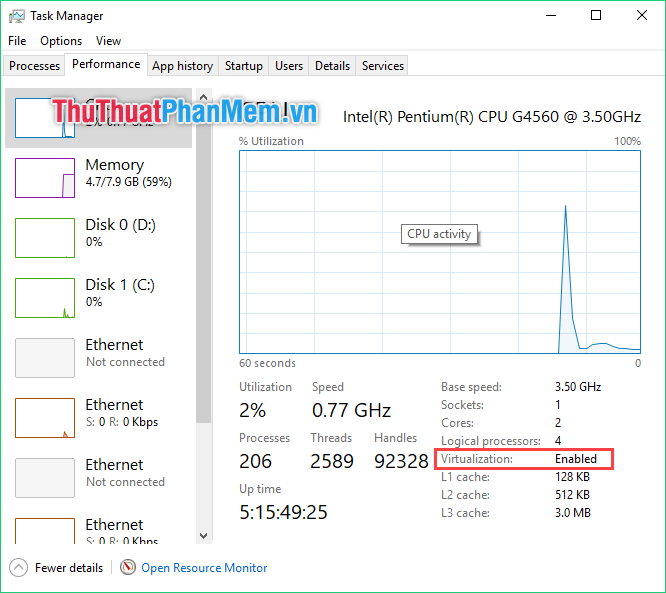
Step 2 : Next, open Control Panel and click Programs .
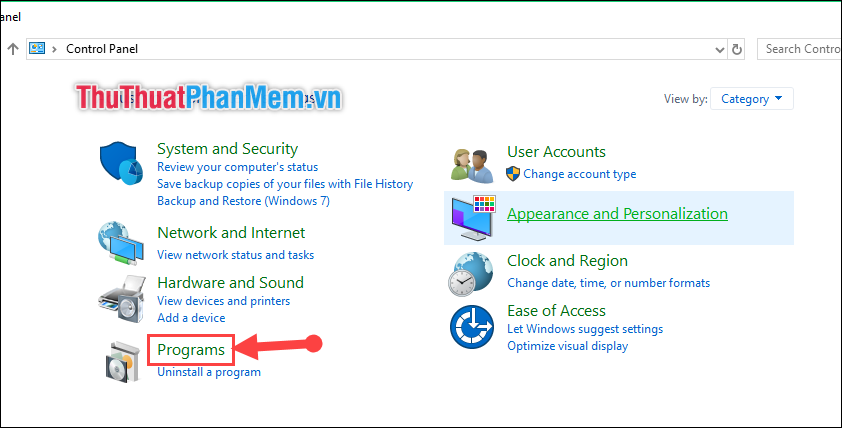
Step 3 : Then select Turn Windows features on or off .
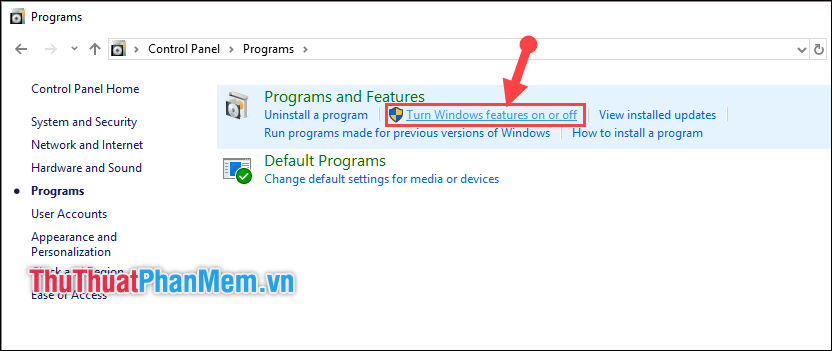
Step 4 : Then tick the Windows Sandbox . And restart Windows.
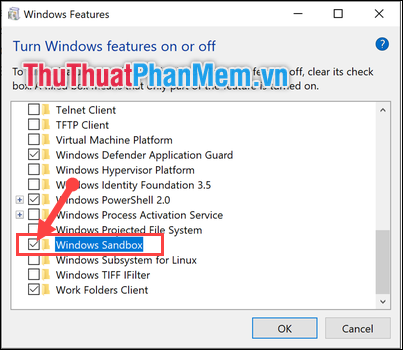
Step 5 : After restarting, go to Start Menu, type Sanbox and then click on the Sandbox icon to launch the program.
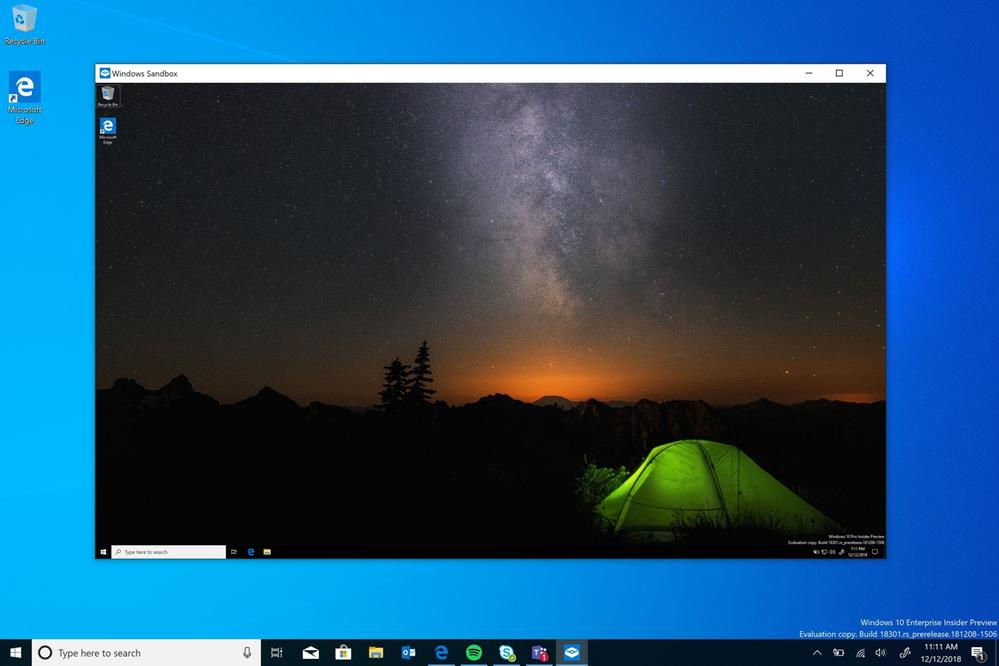
Step 6 : After use, close the Sandbox. However, as mentioned above, closing the Sandbox will remove the program and all the data you have used from the Sandbox. Any programs or files you downloaded during the session will be permanently deleted.
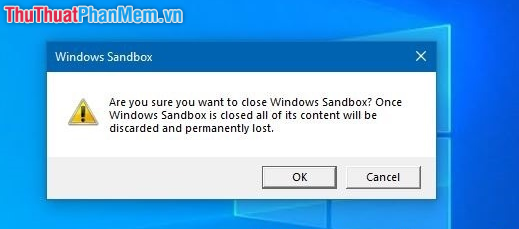
Thank you for watching the article!
You should read it
- How to turn on / off Windows Sandbox on Windows 10
- How to configure Windows Sandbox on Windows 10
- Activate Windows Sandbox on Windows 10 to run the unreliable .exe file
- How to fix the problem of missing the Sandbox feature after updating Windows 10 May 2019
- How to enable sandbox feature on Windows Defender
- How to enable / disable video input in Windows Sandbox on Windows 10
- 7 best Sandbox apps for Windows 10
- How to enable / disable clipboard sharing with Windows Sandbox on Windows 10
May be interested
- How to enable / disable video input in Windows Sandbox on Windows 10
 windows sandbox provides a lightweight desktop environment to safely run applications. this tutorial will show you how to enable or disable video input in windows sandbox for all users in windows 10.
windows sandbox provides a lightweight desktop environment to safely run applications. this tutorial will show you how to enable or disable video input in windows sandbox for all users in windows 10. - Windows Sandbox: The Secret App That Lets You Open Anything Without Risk
 using this tool, you can safely check suspicious files, install suspicious software, or browse dangerous websites without risking damage to your main computer.
using this tool, you can safely check suspicious files, install suspicious software, or browse dangerous websites without risking damage to your main computer. - How to enable / disable clipboard sharing with Windows Sandbox on Windows 10
 starting with windows 10 build 20161, a new group policy setting has been added to enable or disable sharing of clipboard with sandbox. if you enable or do not configure this policy setting, then copying and pasting between the host and the windows sandbox will be allowed.
starting with windows 10 build 20161, a new group policy setting has been added to enable or disable sharing of clipboard with sandbox. if you enable or do not configure this policy setting, then copying and pasting between the host and the windows sandbox will be allowed. - How to fix Windows Sandbox error 'No Hypervisor Was Found 0XC0351000'
 windows sandbox is a handy utility to check for untrusted applications and files in a secure virtual environment. the setup process is pretty straightforward for windows sandbox.
windows sandbox is a handy utility to check for untrusted applications and files in a secure virtual environment. the setup process is pretty straightforward for windows sandbox. - 7 ways to fix 'Windows Sandbox Failed to Start' error
 the windows sandbox tool acts as a temporary virtual desktop environment. however, while trying to use this tool, you may get a 'windows sandbox failed to start' error.
the windows sandbox tool acts as a temporary virtual desktop environment. however, while trying to use this tool, you may get a 'windows sandbox failed to start' error. - 3 Best Windows Sandbox Alternatives for Windows 11 Home
 these alternatives allow you to test untrusted programs and browse the web safely like what windows sandbox offers.
these alternatives allow you to test untrusted programs and browse the web safely like what windows sandbox offers. - Simple Sandbox Tips to Help You Stop Worrying About Malware
 malware attacks have never been more intense, but we're finally finding peace of mind thanks to strategic sandboxing techniques.
malware attacks have never been more intense, but we're finally finding peace of mind thanks to strategic sandboxing techniques. - Microsoft released Windows 10 Insider Preview Build 18353, focusing on Sandbox improvements
 microsoft recently released preview build 18353 (19h1) for windows 10 insider users on fast ring. specifically, this release will mainly focus on bug fixes, along with a few notable improvements to windows sandbox.
microsoft recently released preview build 18353 (19h1) for windows 10 insider users on fast ring. specifically, this release will mainly focus on bug fixes, along with a few notable improvements to windows sandbox. - Protect your computer with Sandbox
 if viruses and malware are common problems or merely users worry that your antivirus program is not enough, you can add a few layers of protection to your computer by installing the sandbox application. one episode
if viruses and malware are common problems or merely users worry that your antivirus program is not enough, you can add a few layers of protection to your computer by installing the sandbox application. one episode - How to use Shelter to sandbox apps on Android
 shelter is a very convenient android security app that allows you to place apps in a sandbox. in the article below, tipsmake will talk about how shelter works and how to use this tool.
shelter is a very convenient android security app that allows you to place apps in a sandbox. in the article below, tipsmake will talk about how shelter works and how to use this tool.










 Turning off unnecessary services in Windows 10 will help your computer run faster
Turning off unnecessary services in Windows 10 will help your computer run faster How to set virtual ram for Win 10 to make the computer run faster and smoother
How to set virtual ram for Win 10 to make the computer run faster and smoother Guide to run hard drive defrag on Windows 10 to speed up Windows
Guide to run hard drive defrag on Windows 10 to speed up Windows How to run games, old software on Windows 10, adjust old software to be compatible with Win 10
How to run games, old software on Windows 10, adjust old software to be compatible with Win 10 How to add programs that start with Windows 10
How to add programs that start with Windows 10 5 cool key combinations in Windows 10 you need to know
5 cool key combinations in Windows 10 you need to know